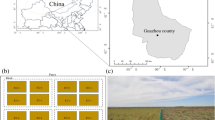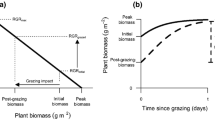Abstract
Degradation of semiarid ecosystems from overgrazing threatens a variety of ecosystem services. Rainfall and nitrogen commonly co-limit production in semiarid grassland ecosystems; however, few studies have reported how interactive effects of precipitation and nitrogen addition influence the recovery of grasslands degraded by overgrazing. We conducted a 6-year experiment manipulating precipitation (natural precipitation and simulated wet year precipitation) and nitrogen (0, 25 and 50 kg N ha−1) addition at two sites with different histories of livestock grazing (moderately and heavily grazed) in Inner Mongolian steppe. Our results suggest that recovery of plant community composition and recovery of production can be decoupled. Perennial grasses provide long-term stability of high-quality forage production in this system. Supplemental water combined with exclosures led, in the heavily grazed site, to the strongest recovery of perennial grasses, although widespread irrigation of rangeland is not a feasible management strategy in many semiarid and arid regions. N fertilization combined with exclosures, but without water addition, increased dominance of unpalatable annual species, which in turn retarded growth of perennial species and increased inter-annual variation in primary production at both sites. Alleviation of grazing pressure alone allowed recovery of desired perennial species via successional processes in the heavily grazed site. Our experiments suggest that recovery of primary production and desirable community composition are not necessarily correlated. The use of N fertilization for the management of overgrazed grassland needs careful and systematic evaluation, as it has potential to impede, rather than aid, recovery.





Similar content being viewed by others
References
Allington GRH, Valone TJ (2010) Reversal of desertification: the role of physical and chemical soil properties. J Arid Environ 74:973–977. doi:10.1016/j.jaridenv.2009.12.005
Allington GRH, Valone TJ (2014) Islands of fertility: a byproduct of grazing ecosystems. Ecosystems 17:127–141. doi:10.1007/s1021-013-9711-y
Asner GP, Elmore AJ, Olander LP, Martin RE, Harris AT (2004) Grazing systems, ecosystem responses, and global change. Annu Rev Environ Resour 29:261–299. doi:10.1146/annurev.energy.29.062403.102142
Augustine DJ, McNaughton SJ (2006) Interactive effects of ungulate herbivores, soil fertility, and variable rainfall on ecosystem processes in a semi-arid savanna. Ecosystems 9:1242–1256. doi:10.1007/s10021-005-0020-y
Bai Y, Han X, Wu J, Chen Z, Li L (2004) Ecosystem stability and compensatory effects in the Inner Mongolia grassland. Nature 431:181–184. doi:10.1038/nature02850
Bai Y, Wu J, Xing Q, Pan Q, Huang J, Yang D, Han X (2008) Primary production and rain use efficiency across a precipitation gradient on the Mongolia Plateau. Ecology 89:2140–2153. doi:10.1890/07-0992.1
Bai Y, Wu J, Clark CM, Naeem S, Pan Q, Huang J, Zhang L, Han X (2010) Tradeoffs and thresholds in the effects of nitrogen addition on biodiversity and ecosystem functioning, evidence from Inner Mongolia grasslands. Glob Chang Biol 16:358–372. doi:10.1111/j.1365-2486.2009.01950.x
Bolland M, Guthridge I (2007) Determining the fertiliser phosphorus requirements of intensively grazed dairy pastures in south-western Australia with or without adequate nitrogen fertiliser. Aust J Exp Agric 47:801–814. doi:10.1071/EA05184
Briske DD, Fuhlendorf SD, Smeins FE (2006) A unified framework for assessment and application of ecological thresholds. Rangel Ecol Manag 59:225–236. doi:10.2111/05-115R.1
Castellano MJ, Valone TJ (2007) Livestock, soil compaction and water infiltration rate: evaluating a potential desertification recovery mechanism. J Arid Environ 71:97–108. doi:10.1016/j.jaridenv.2007.03.009
Chen Q, Hooper DU, Lin S (2011) Shifts in species composition constrain restoration of overgrazed grassland using nitrogen fertilization in Inner Mongolian Steppe, China. PLoS One 6:e16909. doi:10.1371/journal.pone.0016909
Craine JM, Morrow C, Stock WD (2008) Nutrient concentration ratios and co-limitation in South African grasslands. New Phytol 179:829–836. doi:10.1111/j.1469-8137.2008.02513.x
DeMalach N, Kigel J, Voet H, Ungar ED (2014) Are semiarid shrubs resilient to drought and grazing? Differences and similarities among species and habitats in a long-term study. J Arid Environ 102:1–8. doi:10.1016/j.jaridenv.2013.10.016
DeSchrijver A, De Frenne P, Ampoorter E, Van Nevel L, Demey A, Wuyts K, Verheyen K (2011) Cumulative nitrogen input drives species loss in terrestrial ecosystems. Glob Ecol Biogeogr 20:803–816. doi:10.1111/j.1466-8238.2011.00652.x
D’Odorico P, Okin GS, Bestelmeyer BT (2012) A synthetic review of feedbacks and drivers of shrub encroachment in arid grasslands. Ecohydrology 5:520–530. doi:10.1002/eco.259
Dore MHI (2005) Climate change and changes in global precipitation patterns: What do we know? Environ Int 31:1167–1181. doi:10.1016/j.envint.2005.03.004
Evans SE, Burke IC, Lauenroth WK (2011) Controls on soil organic carbon and nitrogen in Inner Mongolia, China: A cross-continental comparison of temperate grasslands. Glob Biogeochem Cycles 25:GB3006. doi:10.1029/2010GB003945
Giese M, Brueck H, Gao Y, Lin S, Steffens M, Kögel-Knabner I, Glindemann T, Susenbeth A, Taube F, Butterbach-Bahl K (2013) N balance and cycling of Inner Mongolia typical steppe, a comprehensive case study of grazing effects. Ecol Monogr 83:195–219. doi:10.1890/12-0114.1
Goldstein LJ, Suding KN (2014) Intra-annual rainfall regime shifts competitive interactions between coastal sage scrub and invasive grasses. Ecology 95:425–435. doi:10.1890/12-0651.1
Gong XY, Chen Q, Dittert K, Taube F, Lin S (2012) Nitrogen, phosphorus and potassium nutritional status of semiarid steppe grassland in Inner Mongolia. Plant Soil 340:265–278. doi:10.1007/s11104-010-0577-x
Gough L, Gross KL, Cleland EE, Clark CM, Collins SL, Fargione JE, Pennings SC, Suding KN (2012) Incorporating clonal growth form clarifies the role of plant height in response to nitrogen addition. Oecologia 169:1053–1062. doi:10.1007/s00442-012-2264-5
Grime JP (2001) Plant strategies, vegetation processes and ecosystem properties, 2nd edn. Chichester, Wiley
Han JG, Zhang YJ, Wang CJ, Bai WM, Wang YR, Han GD, Li LH (2008) Rangeland degradation and restoration management in China. Rangel J 30:233–239. doi:10.1071/RJ08009
Heneghan L, Miller SP, Baer S, Callaham MA, Montgomery J, Pavao Zuckerman M, Rhoades CC, Richardson S (2008) Integrating soil ecological knowledge into restoration management. Restor Ecol 16:608–617. doi:10.1111/j.1526-100X.2008.00477.x
Hooper DU, Johnson L (1999) Nitrogen limitation in dryland ecosystems, responses to geographical and temporal variation in precipitation. Biogeochemistry 46:247–293. doi:10.1007/BF01007582
Hurlbert SH (1984) Pseudoreplication and the design of ecological field experiments. Ecol Monogr 54:187–211. doi:10.2307/1942661
Isbell F, Tilman D, Polasky S, Binder S, Hawthorne P (2013) Low biodiversity state persists two decades after cessation of nutrient enrichment. Ecol Lett 16:421–569. doi:10.1111/ele.12066
Jones MB, Donnelly A (2004) Carbon sequestration in temperate grassland ecosystems and the influence of management, climate and elevated CO2. New Phytol 164:423–439. doi:10.1111/j.1469-8137.2004.01201.x
Kinugasa T, Tsunekawa A, Shinoda M (2012) Increasing nitrogen deposition enhances post-drought recovery of grassland productivity in the Mongolian steppe. Oecologia 170:857–865. doi:10.1007/s00442-012-2354-4
Korfanta NM, Mobley ML, Burke IC (2015) Fertilizing western rangelands for ungulate conservation: an assessment of benefits and risks. Wildl Soc Bull 39:1–8. doi:10.1002/wsb.519
Ladwig LM, Collins SL, Swann AL, Xia Y, Allen MF, Allen EB (2012) Above- and belowground responses to nitrogen addition in a Chihuahuan Desert grassland. Oecologia 169:177–185. doi:10.1007/s00442-011-2173-z
Lan Z, Bai YF (2012) Testing mechanisms of N-enrichment-induced species loss in a semiarid Inner Mongolia grassland, critical thresholds and implications for long-term ecosystem responses. Philos Trans R Soc B Biol Sci 367:3125–3134. doi:10.1007/s00442-011-2173-z
Lebauer DS, Treseder KK (2008) Nitrogen limitation of net primary productivity in terrestrial ecosystems is globally distributed. Ecology 89:371–379. doi:10.1890/06-2057.1
Li Y, Niu S, Yu G (2016) Aggravated phosphorus limitation on biomass production under increasing nitrogen loading: a meta-analysis. Glob Chang Biol 22:934–943. doi:10.1111/gcb.13125
Lohmann D, Tietjen B, Blaum N, Joubert DF, Jeltsch F (2012) Shifting thresholds and changing degradation patterns, climate change effects on the simulated long-term response of a semi-arid savanna to grazing. J Appl Ecol 49:814–823. doi:10.1111/j.1365-2664,2012.02157.x
Mekuria W (2013) Conversion of communal grazing lands into exclosures restored soil properties in the semiarid lowlands of Northern Ethiopia. Arid Land Res Manag 27:153–166. doi:10.1080/15324982.2012.721858
Neff JC, Reynolds RL, Belnap J, Lamothe P (2005) Multi-decadal impacts of grazing on soil physical and biogeochemical properties in southeast Utah. Ecol Appl 15:87–95. doi:10.1890/04-0268
Peters DPC, Havstad KM, Archer SR, Sala OE (2015) Beyond desertification: new paradigms for dryland landscapes. Front Ecol Environ 13:4–12. doi:10.1890/140276
Sasaki T, Okayasu T, Jamsran U, Takeuchi K (2008) Threshold changes in vegetation along a grazing gradient in Mongolian rangelands. J Ecol 96:145–154. doi:10.1111/j.1365-2745.2007.01315.x
Sattari SZ, Bouwman AF, Rodriguez MR, Beusen AHW, Van Ittersum MK (2016) Negative global phosphorus budgets challenge sustainable intensification of grasslands. Nat Commun 7:10696. doi:10.1038/ncomms10696
Steffens M, Ibl AK, Totsche KU, Kögel-Knabner I (2008) Grazing effects on soil chemical and physical properties in a semiarid steppe of Inner Mongolia PR China. Geoderma 143:63–72. doi:10.1016/j.geoderma.2007.09.004
Suding KN, Gross KL, Houseman GR (2004) Alternative states and positive feedbacks in restoration ecology. Trends Ecol Evol 19:46–53. doi:10.1016/j.tree.2003.10.005
Suding KN, Collins SL, Gough L, Clark C, Cleland EE, Gross KL, Milchunas DG, Pennings S (2005) Functional-and abundance-based mechanisms explain diversity loss due to N fertilization. Proc Natl Acad Sci 102:4387–4392. doi:10.1073/pnas.0408648102
Throop HL, Reichmann LG, Sala OE, Archer SR (2012) Response of dominant grass and shrub species to water manipulation, an ecophysiological basis for shrub invasion in a Chihuahuan Desert grassland. Oecologia 169:373–383. doi:10.1007/s00442-011-2217-4
Tietjen B, Jeltsch F, Zehe E, Classen N, Groengroeft A, Schiffers K, Oldeland J (2010) Effects of climate change on the coupled dynamics of water and vegetation in drylands. Ecohydrology 3:226–237. doi:10.1002/eco.70
Tong C, Wu J, Yong S, Yang J, Yong W (2004) A landscape-scale assessment of steppe degradation in the Xilin River Basin, Inner Mongolia, China. J Arid Environ 59:133–149. doi:10.1016/j.jaridenv.2004.01.004
Valone TJ, Meyer M, Brown JH, Chew RM (2002) Timescale of perennial grass recovery in desertified arid grasslands following livestock removal. Conserv Biol 16:995–1002. doi:10.1046/j.1523-1739.2002.01045.x
Wang W, Liu ZL, Hao DY, Liang CZ (1996) Research on the restoring succession of the degenerated grassland in Inner Mongolia: II Analysis of the restoring processes. Acta Phytoecol Sin 20:460–471 (In Chinese with English abstract)
Wedin D, Tilman D (1993) Competition among grasses along a nitrogen gradient, initial conditions and mechanisms of competition. Ecol Monogr 63:199–229. doi:10.2307/2937180
Weltzin J, Loik M, Schwinning S, Williams D, Fay P, Haddad B, Harte J, Huxman T, Knapp A, Lin G (2003) Assessing the response of terrestrial ecosystems to potential changes in precipitation. Bioscience 53:941–952. doi:10.1641/0006-3568(2003)053[0941:ATROTE]2.0.CO;2
Acknowledgements
This work was supported by the National Natural Science Foundation of China (NSFC, 31300386/41071207), the Deutsche Forschungs Gemeinschaft (DFG, project DI 546/3-2), and the Innovation Team Training plan of the Tianjin Education Committee (TD12-5037). We thank the Botany Institute for providing working facilities, Drs. Yingzhi Gao and Marc Giese for their help with field work, Dr. Holger Brueck for his constructive suggestions on experimental design, and Drs. Peter Adler, Yongfei Bai, Kimberly La Pierre, David Schimel, Chris B. Zou and two anonymous reviewers for useful comments on previous drafts of this manuscript.
Author contribution statement
SL, QC and KD designed study; QC, HL, XYG, FP and HW performed the research; QC, SL and DUH analyzed data; QC, DUH, and SL wrote the paper.
Author information
Authors and Affiliations
Corresponding author
Additional information
Communicated by John Dwyer.
In this paper we report results from a six year study in the Inner Mongolian steppe to evaluate whether water and nitrogen addition speeds recovery of semiarid grasslands degraded by overgrazing. We find that supplemental water resulted in strong recovery of perennial grasses, and N fertilizer addition alone increased the dominance of unpalatable annual species, decreasing the stability of production. This shows that nitrogen and water interact to control the recovery of overgrazed grassland.
Electronic supplementary material
Below is the link to the electronic supplementary material.
Rights and permissions
About this article
Cite this article
Chen, Q., Hooper, D.U., Li, H. et al. Effects of resource addition on recovery of production and plant functional composition in degraded semiarid grasslands. Oecologia 184, 13–24 (2017). https://doi.org/10.1007/s00442-017-3834-3
Received:
Accepted:
Published:
Issue Date:
DOI: https://doi.org/10.1007/s00442-017-3834-3




